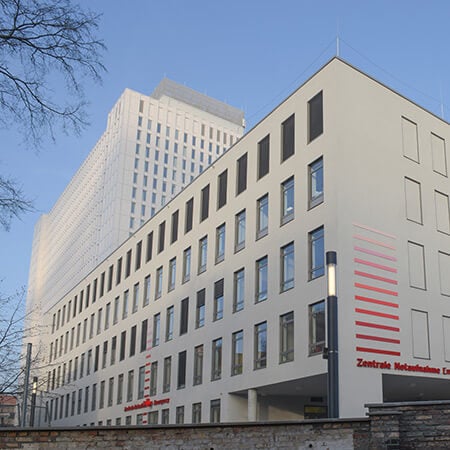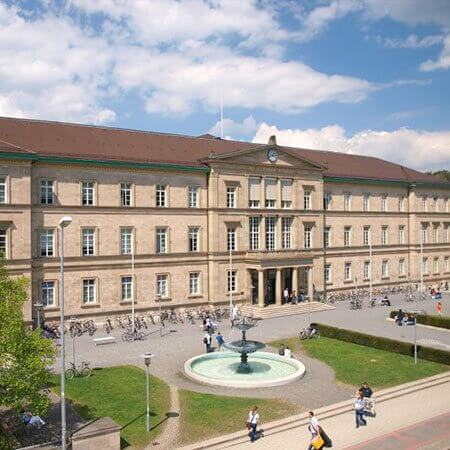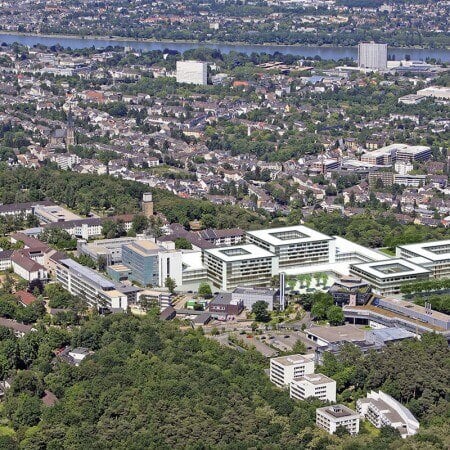Neuroblastoma is a tumor of the nervous system. Here you’ll find everything about neuroblastoma: how common it is, its symptoms, peculiarities of the diagnosis making, what methods of medical care are there for children with cancer, and the chances for recovery from this form of cancer.
Content
- Overview
- Incidence of ganglioneuroblastoma
- Symptoms
- Treatment
- Staging
- Treatment of intermediate-risk neuroblastoma
- Statistics on recovery from neuroblastoma
- Prices for treatment
- Undergoing treatment of neuroblastoma with Booking Health
Overview
Neuroblastoma is a form of cancer that grows from mutated immature nervous cells.
Neuroblastoma can appear wherever nervous system tissue is present. Cancer most often grows in the adrenal glands (about 50% of all children with neuroblastoma). With cancer of such origin, the tumor can also grow in the abdomen, pelvis. Often, the neuroblastoma tumor appears in the abdomen (about 75% of all children with neuroblastoma). In about one-fifth of patients with neuroblastoma cancer grows in the chest and neck.
Some neuroblastomas remain where they started, while others grow further. In about 50% of people with neuroblastoma, doctors detect metastases in the bones at the time of diagnosis making. Less commonly, cancer cells can spread to the brain, lungs, or skin.
Incidence of ganglioneuroblastoma
Ganglioneuroblastoma is a rare type of tumor which accounts for only 0.5% of all cancer cases.
Ganglioneuroblastoma represents the type of tumor with foci of hemorrhage and necrotic areas. Ganglioneuroblastoma ranks second in frequency of occurrence among nervous system cancers. It accounts for about 40% of the tumors in this group. In half of the cases, ganglioneuroblastoma is located in the retroperitoneal space.
Ganglioneuroblastoma is the result of malignant transformation of the ganglioneuroma and is a type of neuroblastoma. To date, there’s no accurate information about the causes of ganglioneuroblastoma. Most of the time ganglioneuroblastoma occurs in children, mainly in the age range from 4 to 10 years.
Symptoms
Many children with neuroblastoma experience no symptoms at all. Cancer is usually detected accidentally. As a rule, children begin to complain when cancer spreads metastases.
Manifestations of the disease can be very diverse. They depend mainly on the localization of cancer metastases. The first symptom in children with neuroblastoma may be the tumor itself or metastases, which can be felt during palpation. In some children with neuroblastoma, a swollen belly attracts attention. If the tumor has grown in the abdominal cavity, then nonspecific symptoms such as abdominal pain, constipation, a feeling of heaviness in the abdomen, or diarrhea may appear. If the tumor compresses the ureter, the child with neuroblastoma may have urinary retention. Tumors that grow close to the spine can invade into the spinal canal. Therefore, the child with neuroblastoma of such localization may have specific neurological symptoms.
Common symptoms children with neuroblastoma experience are:
- Fatigue, loss of strength, weakness, pallor
- Persistent fever for no apparent reason, sweating
- Swelling in the abdomen or neck; enlarged lymph nodes
- Bloating
- Loss of appetite, nausea, vomiting, and, as a result, weight loss
- Bone pain
Treatment
Children with neuroblastoma should only be treated by doctors from pediatric hospitals specializing in pediatric oncology. Also, in such hospitals, doctors of different medical specialties participate in treatment planning. All doctors cooperate closely, they discuss cases of their patients with neuroblastoma and draw up treatment plans together.
Any treatment protocol for children with neuroblastoma is aimed to provide therapy with minimum health consequences after the treatment completion.
The individual peculiarities of the diagnosis influence a treatment choice for a child with neuroblastoma. In some children with neuroblastoma, surgery is sufficient; in others, it’s necessary to combine several methods of cancer care.
The methods that specialists use in the treatment of neuroblastoma include surgery, chemotherapy, and radiation therapy. For children with a very high risk of relapse additional high-dose chemotherapy, and autologous bone marrow transplantation, or immunotherapy are prescribed.
Surgery is performed for a tumor excision or tissue sampling for further histological examination. When chemotherapy is carried out, patients receive drugs that block cell growth, and thus chemotherapy destroys the malignant cells. Usually, doctors administer combinations of different drugs, in which each drug affects cancer cells in its own way. As a result, maximum effectiveness against cancer cells is achieved.
Staging
Until 1988, stages of the disease were determined according to the TNM system. However, a modified system with the elements of the previous one was approved later the same year, i.e. the International Neuroblastoma Staging System.
For stage identification, clinicians use the International Neuroblastoma Staging System. With the International Neuroblastoma Staging System, specific factors are assessed in order to determine cancer spreading, i.e. cancer invasiveness in patients with neuroblastoma.
In the International Neuroblastoma Staging System, tumors are divided into first to third stages, fourth stage (with metastases), and separate stage four for infantile metastatic pathology.
- The first stage is characterized by the tumor localization at its primary site
- At the second stage, neoplasm invades the surrounding tissues
- At the third stage, a tumor spreads along the spine on both sides, affecting the lymph nodes
- By the fourth stage of development, a pathological formation spreads to the distant tissues and organs
However, the International Neuroblastoma Staging System allows specialists to assess the degree of malignancy in a child with cancer, which is essential for the treatment planning.
Even though experts still operate the International Neuroblastoma Staging System, establishing neuroblastoma risk groups (International Neuroblastoma Staging System of risk group) is currently of choice worldwide. Operating this type of International Neuroblastoma Staging System, the cancer stage is identified before starting the treatment of children with neuroblastoma. Along with using the International Neuroblastoma Staging System of risk groups during choosing a treatment tactic, the health condition of a child with neuroblastoma and the molecular features of cancer are considered as well.
In the risk group International Neuroblastoma Staging System, the advanced stages (metastatic cancer) of neuroblastomas are subdivided as well.
With cancer, the forecast is influenced by the level of the neoplasm’s activity. Defining the cancer stage creates a basis for the choice of the optimal therapeutic strategy for children with neuroblastoma.
Treatment of intermediate-risk neuroblastoma
Each child with neuroblastoma belongs to a characteristic risk group or therapeutic group even before the treatment start. Recent guidelines distinguish three clinical groups of cancer: the low-risk, the high-risk, and the intermediate-risk neuroblastoma. Each of these groups has its own treatment protocol. Therefore, each child with neuroblastoma undergoes treatment according to the therapeutic regimen that considers the risk group.
The intermediate-risk neuroblastoma group includes children with cancer at the advanced stages. Therefore, the intermediate-risk neuroblastoma group consists of people with neuroblastoma at:
- Stage 2, under 50% of the tumor was removed surgically
- Stage 3, children under 18 months with no MYCN amplification
- Stage 4, children under 12 months with no MYCN amplification and children with the unfavorable histopathology
Treatment regimen for intermediate-risk neuroblastoma consists of surgery, first of all. Then people with intermediate-risk neuroblastoma receive chemotherapy. Chemotherapy for intermediate-risk neuroblastoma consists of six intensive chemotherapy courses. If the child with intermediate-risk neuroblastoma wasn’t operated before chemotherapy, then doctors perform surgery for intermediate-risk neuroblastoma after chemotherapy. As intermediate-risk neuroblastoma diminishes in volume, it becomes easier to conduct the operation.
Induction chemotherapy consists of composite cytostatics. The drugs for intermediate-risk neuroblastoma are administered in specific doses per session. Drugs are generally prescribed to children with neuroblastoma in pill form.
If after the intensive chemotherapy doctors still find intermediate-risk neuroblastoma active, then children with cancer older than 18 months receive radiation therapy for intermediate-risk neuroblastoma. The radiation dose ranges from 36 to 40 gray. Radiation therapy is carried simultaneously with the maintenance chemotherapy. If the intermediate-risk neuroblastoma wasn’t operated on at all (for example, if at the beginning of intermediate-risk neuroblastoma therapy only a biopsy was conducted), it may become so reduced in size after chemotherapy that it can be excised by surgery. Surgery for intermediate-risk neuroblastoma is performed either during or after chemotherapy. The duration of the whole treatment of intermediate-risk neuroblastoma is about a year.
Statistics on recovery from neuroblastoma
It’s quite difficult to assess individual chances for recovering in patients with neuroblastoma. Each case is influenced significantly by the tumor activity a child was diagnosed with.
Generally, young patients with intermediate-risk neuroblastoma have a rather favorable prognosis. The average recovery rate of people with intermediate-risk neuroblastoma exceeds 90%. Kids with intermediate-risk neuroblastoma that are under 18 months old, also have good prognosis, which is connected with favorable molecular characteristics of intermediate-risk neuroblastoma. Most older children with intermediate-risk neuroblastoma have the recovery rate at about 50%.
Prices for treatment
The cost of treatment with tumor resection for neuroblastoma stage 1-3 in German hospitals starts at 12,612 EUR.
The cost of treatment with chemotherapy for neuroblastoma stage 1-3 in German hospitals starts at 6,547 EUR.
The cost of treatment with radiotherapy for neuroblastoma stage 1-3 in German hospitals starts at 15,300 EUR.
The cost of treatment with high-dose chemotherapy for stage 4 neuroblastoma in German hospitals starts at 85,450 EUR.
Undergoing treatment of neuroblastoma with Booking Health
You can undergo treatment of neuroblastoma abroad using the services of the medical tourism company Booking Health.
With Booking Health, you get:
- Individual approach. The selection of hospitals and specialists is carried out following the medical requirements and wishes of the clients.
- Travel support (visa issuing, accommodation booking, etc.).
- Lower prices (Booking Health works directly with the best medical centers).
Booking Health can start working on your case right now. All you need to do is to leave a request on the website, and a medical advisor will contact you as soon as possible.
Authors: Dr. Nadezhda Ivanisova, Dr. Farrukh Ahmed




















